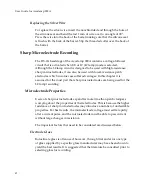
User
Guide
for
Axoclamp
900A
of
current
at
50
nA)
the
change
in
concentration
of
A
inside
a
cell
100
μ
m
in
diameter
is
1
mM.
If
A
is
an
impermeant
ion,
the
cell
may
swell
due
to
the
inflow
of
water
to
balance
the
osmotic
pressure.
The
injection
of
a
permeant
ion,
such
as
chloride,
can
significantly
alter
the
equilibrium
potential
for
that
ion.
Impaling
Cells
Start
with
the
Axoclamp
900A
in
IC
mode
(I
‐
Clamp):
Fill
a
microelectrode
with
internal
solution
and
secure
it
firmly
in
the
pipette
holder.
Be
sure
to
support
the
headstage
with
your
other
hand
so
that
the
micromanipulator
does
not
have
to
absorb
your
force.
Advance
the
electrode
until
its
tip
enters
the
bath.
Press
the
Pipette
Offset
button
to
null
the
offset.
Check
the
stability
of
the
bath
electrode
and
microelectrode.
Drifts
in
Scaled
Output:
Membrane
Potential
indicates
that
the
electrode
wires
probably
need
to
be
rechlorided.
Also
check
for
a
changing
tip
potential
by
passing
a
steady
current,
as
described
above.
Check
the
Tuning
checkbox
and
observe
the
Scaled
Output:
Membrane
Potential
on
a
scope.
Move
the
electrode
tip
close
to
where
cells
are
likely
to
be
encountered,
and
then
increase
Pipette
Capacitance
Neutralization
in
the
Axoclamp
900A
Commander
to
give
the
fastest
step
response.
It
is
advisable
to
adjust
the
capacitance
neutralization
with
the
microelectrode
as
close
as
possible
to
the
final
position,
since
moving
the
electrode
can
change
C
t
and
invalidate
the
setting.
It
may
be
wise
to
slightly
under
‐
compensate,
because
changes
in
the
solution
level
could
lead
to
oscillations
that
may
destroy
the
cell.
86
















































